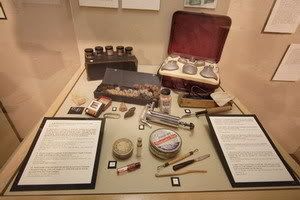
Restoration tools, Museum of Funeral Customs
After the body is rewashed and dried, cosmetics are applied to make it appear more lifelike and to create a "memory picture" for the deceased's friends and relatives. In the United States and Philippines baby powder or other deodorizers are used on the body for a pleasing fragrance. For babies who have died, the embalmer applies a light cosmetic massage cream after embalming to provide a natural appearance; massage cream is also used on the lips to prevent them from dehydrating, and the infant's mouth is often left open a bit for a more natural expression. If possible, the funeral director uses a light, translucent cosmetic; sometimes, heavier, opaque cosmetics are used to hide bruises, cuts, or discoloured areas. Makeup is applied to the lips to mimic their natural color.
Sometimes a very pale or light pink lipstick is applied on males, while brighter coloured lipstick is applied to females. Hair gels or hair spray is applied to style the hair, especially for deceased who are male. Mortuary cosmetizing is not done for the same reason as make-up for living people; rather, it is designed to add depth and dimension to a person's features that the lack of blood circulation removes. Warm areas, where blood vessels in living people are superficial, such as the cheeks, chin and knuckles have subtle reds added to recreate this effect, while browns are added to the palpabrae (eyelids) to add depth, especially important as viewing in a casket creates an unusual perspective rarely seen in everyday life. During the viewing, pink-coloured lighting is sometimes used near the body to lend a warmer tone to the deceased's complexion.
No comments:
Post a Comment